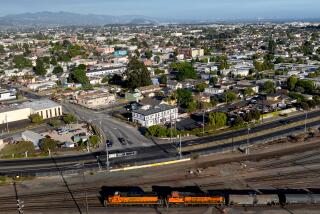Stations Forced to Choose War Coverage Source : Media: In come cases, inane local San Diego coverage is substituted for compelling network reports.
- Share via
SAN DIEGO — To cut away or not to cut away, that was the question facing the local network-affiliated television news departments Wednesday night.
As war began in the Middle East, networks were the primary source of battle news. They were covering events where they happened, as they happened, especially CNN, which had reporters providing gripping accounts direct from Baghdad.
At the same time, the local news departments were geared up, ready to go with local angles on events.
KFMB-TV (Channel 8) made the commitment early in the evening to break away from CBS coverage. Long before the President’s speech at 6 p.m., Channel 8 was dumping the CBS coverage in favor of its own local stories.
While the other stations were emphasizing network coverage, with reporters in Washington, Saudi Arabia and the other key locations, Channel 8 showed reporter John Culea using a wood pointer and a paper map pinned to a bulletin board to analyze events; Culea spent a few weeks reporting from the Middle East last fall for the station.
“I felt some of what CBS was doing had bogged down at that point,” Channel 8 news director Jim Holtzman said. “I don’t think we were trying to set John and Mitch (Duncan, who also had reported from the Middle East a few months ago) as overwhelming experts, just as witnesses.”
Channel 39 did a few quick break-ins, but didn’t start emphasizing its local coverage until 7 p.m., when it interrupted network coverage for 35 minutes. Channel 10 took a similar approach, providing two quick breaks before 7 p.m., and an 11-minute report at 7:16 p.m., before doing a 43-minute newscast at 8 p.m. when the network adjusted its coverage to allow the East Coast affiliates to do their 11 p.m. newscasts.
“We thought the stuff (ABC anchor Peter) Jennings was offering was too good just to dump out and hype that we can go local,” Channel 10 assistant news director Bill Gray said.
Channel 10 made another tough decision: It began airing commercials during the 7 p.m. hour, the only local station to run ads during the early evening.
“For us it was easier to know that we could go for four minutes or whatever amount of time and then have a minute to recoup, but obviously there were also economic considerations,” said Channel 10 assistant news director Bill Gray.
Each of the stations walked a fine line between promoting their local coverage and depriving viewers of the breaking network news coverage.
At 7:00 p.m., for example, KGTV (Channel 10) was carrying an ABC interview with Rep. Les Aspin, chairman of the House Armed Services Committee, while channels 8 and 39 were doing local reports.
Although it included some relevant local news, such as reports of upgraded security at the airport and the border, much of the local coverage focused on reactions from families and packaged features recorded long before the war started. Many of the reports bordered on the inane, such as Channel 10’s footage from a helicopter illustrating that nothing was going on at the 32nd Street Naval Station.
Each of the local stations presented a variety of experts on the Middle East and warfare. Republican U.S. Rep. Randy (Duke) Cunningham, a former Navy fighter pilot appeared on several local radio and television stations, and provided a rare touching moment when he described to Channel 39’s Marty Levin his emotions before going into battle for the first time.
Channel 39 also presented a psychologist to help viewers adjust mentally to war.
“Our primary concern was what we could do to help our viewers cope with the situation,” Channel 39 news director Irv Kass said.
However, the real question, from the viewer’s perspective was: Was the local information more compelling than the network reports? The answer, in almost every case, was no.
While the other stations dabbled in local reports, many viewers turned to KUSI-TV (Channel 51), which simply carried the CNN feed, without turning to local stories produced by their own team until the channel’s regularly scheduled 10 p.m. newscast. Viewers also had the option of turning to KPBS-TV (Channel 15), which was carrying the national Public Broadcasting Service coverage or simply turning to CNN on cable systems.
Channel 39 also was affiliated with CNN, and made the unusual decision to break away from its affiliated network, NBC, to carry the CNN coverage.
“We didn’t want our primary affiliation to govern (our decision),” Kass said.
Channel 39’s decision was one of the bright points of the local coverage. Another was anchorman Hal Clement, who only recently took over the main anchor chair for Channel 8. He proved calm and adept at dealing with the swirl of activity.
Channel 10’s coverage, as always, was slick. The station had a modern-art logo, “Your Homefront Station,” all set up and ready to go. But slick isn’t necessarily better when there is a breaking news story.
At 11 p.m., Channel 10 went with a 90-minute program, which focused on two phone-in segments.
Some may have found it interesting, but people seeking the unraveling international war news certainly jumped for the remote control.
More to Read
The complete guide to home viewing
Get Screen Gab for everything about the TV shows and streaming movies everyone’s talking about.
You may occasionally receive promotional content from the Los Angeles Times.






